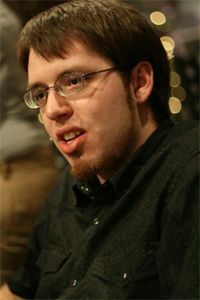by John Tyson
Seven members of Franconia Conference received scholarships to attend a day long symposium entitled, “Pilgrims on a Journey: Exploring Mennonite Spirituality Past and Present.”
 The symposium, which took place on May 31, “came out of the desire to investigate spirituality in order to preserve and interpret its meaning for today’s church community,” said symposium organizer Forrest Moyer, who works at the Mennonite Heritage Center in Harleysville, Pa. “Spirituality is a relevant topic. There is interest growing in Catholic spirituality, but we want to look at our own heritage.”
The symposium, which took place on May 31, “came out of the desire to investigate spirituality in order to preserve and interpret its meaning for today’s church community,” said symposium organizer Forrest Moyer, who works at the Mennonite Heritage Center in Harleysville, Pa. “Spirituality is a relevant topic. There is interest growing in Catholic spirituality, but we want to look at our own heritage.”
The morning session consisted of an overview of Mennonite expressions of spirituality, beginning with its origins in the 16th century and leading up to the 20th century. Several theologians and historians, including Dr. John Rempel, professor of theology at Associated Mennonite Biblical Seminary, Salford Mennonite’s Dr. John Ruth, and Dr. Dawn Ruth Nelson, of Methacton Mennonite Church, explored the forms of spirituality used by Anabaptists. Prayer, baptism, hymns, and fraktur were highlighted as the modes often used by Mennonites of the past as they sought to express communal and individual spirituality.
After examing historical roots, the symposium shifted in the afternoon to focus on contemporary Mennonite spirituality. The audience joined in the conversation as it turned towards contemporary Mennonite spiritual experiences within the community. The scholarships from Franconia Mennonite Conference broadened the dialogue and diversified the audience which gathered to further explore spirituality from a Mennonite perspective.
Ken Ray, a scholarship recipient, affirmed the symposium’s value. “I want to broaden my spiritual horizons. I am here with my church family to find discernment for my life,” he said.
 Another scholarship recipient, Topher Maddox of NewStart Fellowship, came to the conference–as some others–rather unfamiliar with the how Mennonite spirituality had been expressed in the past. “I desire to understand the history of Mennonite spirituality in this community; I want to hear the stories. It is important, however, to learn how to marry them with new traditions of spirituality. I appreciate and value the emphasis of artistic spirituality as seen in the art of designing fraktur.”
Another scholarship recipient, Topher Maddox of NewStart Fellowship, came to the conference–as some others–rather unfamiliar with the how Mennonite spirituality had been expressed in the past. “I desire to understand the history of Mennonite spirituality in this community; I want to hear the stories. It is important, however, to learn how to marry them with new traditions of spirituality. I appreciate and value the emphasis of artistic spirituality as seen in the art of designing fraktur.”
In the midst of the thought-provoking and informative symposium, where almost all forms of spirituality had been discussed, Tamela Prather took the floor and announced, “Every day is sacred.” The conclusion left little else to be said.
The opinions expressed in articles posted on Mosaic’s website are those of the author and may not reflect the official policy of Mosaic Conference. Mosaic is a large conference, crossing ethnicities, geographies, generations, theologies, and politics. Each person can only speak for themselves; no one can represent “the conference.” May God give us the grace to hear what the Spirit is speaking to us through people with whom we disagree and the humility and courage to love one another even when those disagreements can’t be bridged.
